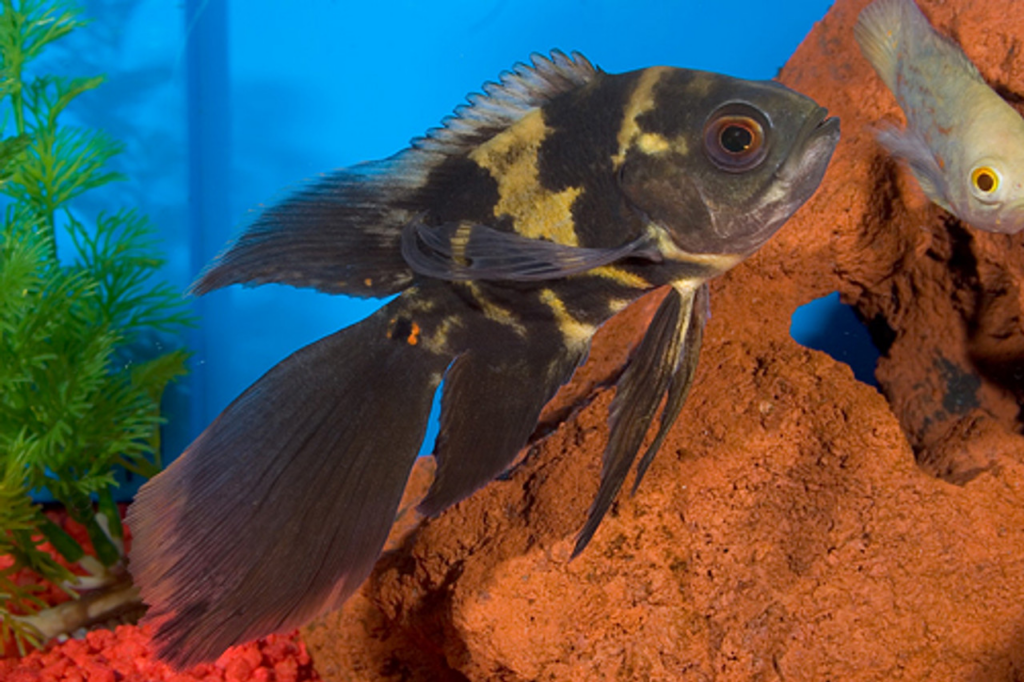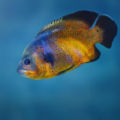Everything you need to know before adding the Longfin Oscar fish to your community tank. This guide includes care tips, health advice and breeding practices.

Introduction to Longfin Oscar
All fishkeeping enthusiasts know the Oscar fish as one of the most popular aquarium fish varieties, but do you know every unique fish in this species? Today, I’ll focus on the Longfin Oscar, also called the Longfin Red Tiger Oscar.
It’s a striking tiger-striped Oscar fish with exaggerated features and a bubbly personality. Although this variant has dark scales, it’s still one of the most sought-after ornamental fish species for aquarium lovers.
Why did I single this one out of the many unique Oscar variants? You’re about to find out! If you want to learn every important detail about caring for the Longfin Oscar, then join me on this ride.
History and Origin
It shouldn’t surprise you to learn that the Longfin Oscar origins go back to the Amazon Basin in native South America. However, this particular variety is a product of selective fish breeding.
It didn’t migrate from the slow-moving rivers. Instead, aquarium enthusiasts experimented by pairing various Oscars like the Red and Black Oscars in captivity to create more beautiful species of these cichlids.
Since the discovery of the Longfin Oscar, Oscar fish experimentation has continued growing as breeders seek to create more ornamental cichlids. Did they succeed? We’ll find out in the coming years, but for now, let me tell you how to identify a Longfin Oscar fish.
Physical Characteristics

Thanks to selective breeding practices, the Longfin Oscar’s appearance is very noticeable. You’ll immediately notice its long fins extending from its head to its tail, which gives it an elegant look.
Its body is robust and lateral and would grow up to 20 inches like regular Oscars, but it has other distinctive fish features, including its charcoal black scales mixed with red, brown, or orange stripes.
These elongated fin ornated cichlids also have bold and expressive eyes that help them interact with humans and other tank mates. But beyond their physical characteristics, Longfins also have other ornamental fish traits like territoriality.
We’ll get to that soon, but first, let’s discuss care requirements.
Care Requirements for Longfin Oscar Fish

You must focus on basic and special Longfin Oscar care if you want your pets to live a long and healthy life. Before I highlight optimal fish care practices that also apply to this species, here’s a look at specific fin care because of their unique physical traits.
Fin care for Oscars
Fin care for Oscars focuses on creating a tank environment that accommodates their large fins. For Longfin Oscars, you must create extra space to allow them to move their fins without injuring themselves.
Also, periodically check their fins for tears or injuries and treat them immediately. Ensure you always have optimal water parameters beyond the basic requirements of water quality for cichlids. Check out the tank setup below.
Ideal Tank Setup for Longfin Oscar

Your Longfin Oscar tank setup isn’t that different from other Oscars’ aquariums, but you must consider the slight differences. I’ll break it down for you here —
Ideal Tank Size
Get a large tank that can hold at least 75 gallons of water for one Longfin Oscar. Then, add 10 gallons or more for every additional fish you put in the tank. Large tanks allow the fish to move freely without fear of hurting their long fins or getting territorial.
Water Parameters
Optimal water conditions for Longfins require — 74 – 78℉ water temperature, 6 – 8 pH balance, but 7 is ideal, and 5 – 20 dGH hardness. Add a good filtration system to speed up the Nitrogen cycle and ensure the water stays clean even after feeding.
Decor and Substrate
Your aquarium environment design should be similar to the Amazon rivers of South America. This guarantees that your Longfin Oscars will not feel alienated even though they’re not in their natural habitat.
Use soft aquatic decor for Oscars and substrates like smooth pebbles, gravel, and sand paired with natural soft plants or artificial ones. Secure your decorations to avoid displacement when your Longfin Oscar starts swimming and playing.
Feeding and Diet
You don’t need to do much when planning your Longfin Oscar diet because they’re omnivores that eat meat and plants. Feeding and diet would change if there’s a health challenge, but balanced fish feeding always comes first.
For more on feeding your aquatic pets check out The Ultimate Guide to Fish Food: Pros and Cons & Best Choices!
Diet
A regular cichlid nutrition plan filled with high-quality commercial pellets and flakes, freeze-dried, and live food is perfect. For live food, you can feed your Longfins with worms, crickets, brine shrimps, and small fish, while vegetable matter works as plant-based food.
Feeding
Feeding your Longfin Oscars with a balanced diet is good for enhancing fish coloration, but be careful. Don’t overfeed your pets. Always serve them in small portions; they can finish within 2 to 3 minutes.
They’re messy eaters, so prepare to clean leftovers. Feed them only twice daily, but depending on their health status, you may reduce or increase the feeding times.
Health and Common Diseases
So I mentioned that your Longfin Oscar’s health will determine its feeding and diet, and now you’re wondering how that works. As a pet owner, you can do your best to prevent fish disease, but little mistakes happen.
If you pay attention to your cichlid’s wellness, you’ll be able to tell when there’s a problem. Because they’re typically active, laziness, loss of appetite, and tiredness are alarm raising signs. Also, abnormal fin damage and discoloration mean your pets may have an infection.
Common Diseases Plaguing Longfin Oscars
- Fin Rot: Damaged and Discolored Fins caused by bacterial infections.
- White spot (Ich): Grainy white growth on your pet’s scales caused by fungal and bacterial infections.
- Parasites: External parasites latching onto your fish’s skin and sucking their blood.
For more details checkout our article on How to Treat Ich Outbreaks in Your Freshwater Fish!
Disease Management for Longfin Oscars
Some disease management tips for Longfin Oscars include:
- Maintaining the best water quality and parameters
- Incorporating a balanced diet into their daily feeding
- Reacting in record time to physical changes
When your Longfin Oscar shows signs of sickness, immediately take it to the fish vet for diagnosis and treatment.
Breeding Longfin Oscar Fish

Are you ready to breed a Longfin Oscar fish? Do you have the facilities for successful fish breeding, or would you like to know?
Breeding Longfin Oscars is a simple process if you follow these steps carefully.
Step One: Breed Selection
Choose healthy and mature adult Longfin Oscars, one male and one female, for this process. Males have rounder heads with larger bodies, while the females are smaller in comparison. Ensure they have no genetic or health defects, and then move them to the breeding tank.
This video has been very helpful in identifying the sex of Oscar fish, I highly recommend it:
Step Two: Breeding Conditions
Your breeding tank should be separate from the regular Longfin Oscar tank. If you must use the same tank, separate the breeding part with a boundary so you can adjust the water conditions to suit your purpose.
Increase the water temperature to 80 – 84℉ to prepare the female’s body for breeding. Add caves for hiding and a spawning mop to the substrate for laying the eggs.
Step Three: Spawning
The male Longfin Oscar chases the female around the tank and nudges her belly to lay eggs. Once she spawns the eggs on the mop, the male fertilizes them externally, clustering them in a membrane.
After spawning and fertilization, the adults should be separated from their young so that they don’t mistake the eggs for food.
Step Four: Fry Care
Within four to six days, the eggs will hatch, and the fry will feed on the yolk sack for the first two days. Afterward, you must feed them infusoria, and after five days, add crushed flakes and crushed pellets for longfin fish fry to the diet.
Please don’t ignore any of these fry-rearing tips because your pets are sensitive and vulnerable to diseases at this stage. Monitor the water parameters and ensure they stay within a good quality range.
Step Five: Reintegration
Once the fry starts growing, separate the stronger ones from the weaker ones to prevent predation. After about two weeks, all the Longfin Oscar fish should be grown and ready to join the main tank.
Do you see how easy cichlid reproduction is? Why won’t you consider adding them to your aquarium yet?
Behavior and Compatibility

Longfin Oscars are active, intelligent, and territorial because of their physical characteristics. Remember I told you earlier that I’ll explain how territoriality works? Well, the time has come.
Longfin Oscar Behavior
Longfin Oscars react to stimuli, whether you feed them or interact with toys and other fish. They have the general Oscar fish temperament of wanting enough space to swim but also get territorial because they don’t like anything contacting their long fins.
This species loves showing off when swimming, so it can get aggressive if it feels as though its tank mates are taking its attention.
Longfin Oscar Compatibility
Longfin Oscar fish thrive in peaceful fish communities, so they need mild-mannered tank mates that won’t intrude in their space. Pair them with larger cichlids, common plecos, and large freshwater fish that can handle sharing a space with such territorial species.

Your goal when creating a community tank with Longfin Oscars as the center of attraction is managing cichlid interactions. Avoid anything that’ll cause hostility, aggression, or predation.
Conclusion
I’m sure you can confidently start your aquarium after reading this Longfin Oscar care overview. You should also be able to show more appreciation for Oscar fish because the Longfin is a low-maintenance ornamental species.
That doesn’t mean you must neglect all the fishkeeping tips you’ve picked from this guide. Or take for granted that this variety requires special ornamental fish care for its long fins and hardy skin. But you should be happy you wouldn’t bend over backward to successfully breed a Longfin Oscar fish.
Daily maintenance of the aquarium, monitoring the fish’s health, and feeding your pets with the right diet are enough.











I would put a pair of indo datnoids🔵 5 silver dollars and 1 single male longfinned tiger Oscar cichlid🚩